Abstract
Agriculture was once an engine in the economic growth of Thailand. However, the employment in agricultural sector has been declining and the dependence of economy on agriculture has declined since a few decades ago. Thailand has transformed to be an industrialized country from an agrarian country. The agriculture sector has been confronting with the issue of labor shortage.
This study finds out the changes in the agricultural labor force status of Thailand over the periods of time in terms of employment status from agriculture to non-agriculture, educational attainment, percentage of the population and minimum wage rate. Thailand could take advantages from increasing number of migrant/alien workers from its neighboring countries who come to the country due to its highest minimum wage rate. It was found that the alien/migrant workers have been contributing to the production and the economy. These workers could supplement the labor shortage in the agricultural activity.
Keywords: Agriculture, labor force, Thailand, alien workers, impacts on the economy
Changes in the agricultural labor force of Thailand
The agricultural sector of Thailand was once an engine of the country’s economic growth. Over the past four decades, agricultural land expansion has increased the outputs of the economy and the agricultural sector gained a major comparative advantage in the international trade. Due to its labor-abundance in the past, agricultural sector could even provide supplies to the industrial sector with cheap labors and other production factors. Agriculture has been playing a crucial role even though land surplus started to vanish in the 1980s. (Siamwalla, 1996)
The share of export to GDP has increased from 26% in 1990 to 64% in 2008. Thailand has moved from classic primary export dependence where there was a restricted expansion of manufacturing employment of only 14% of the labor force in 1990 to export-lead industrialization where there was a greater use of labor in the manufacturing industry accounting for 19.5% in 2008. Nevertheless, even though Thailand exports about more than half of its GDP, it is very interesting to note that Thailand has a larger service sector than the manufacturing sector. The changes in industrial structure in Thailand were largely similar to those in Japan. From 1920-70, in Japan, the decline of agriculture has led directly to the expansion of services. The employment in the manufacturing industry peaked around one-third of the total labor force (Singelmann, 1978).
From 1947-2008, Thailand has also experienced a drastic decline in agricultural employment from 84.8% in 1947 to 42.4% in 2008, a rapid rise in service employment from 12% to 33%, and an increase in manufacturing employment from 2.4% to 20% (Nitungkorn, 1985). In 2008, the service employment share is 8 percentage points higher than the manufacturing employment share.
From an agrarian country, Thailand has turned out to be a more industrialized country. Labor market has been transformed in various dimensions such as population, education, labor force structure, wages and working hours. Thailand becomes an even more educated society. Workers with secondary level of education or higher increased from 17% in 1990 to 25% in 2008.
As shown in the Fig. 1, the percentage of agricultural labor shows a significant decline from 72.99% in 1975 to 34.26% in 2015 September according to the Labor Force Survey. Meanwhile, the labor force employed in the non-agricultural sector rose from 27.01% in 1975 to 65.74% in 2015.

Fig. 1. Percentage changes in the labor force employment status from agriculture to non-agricultural sector in the period from 1975 to 2015
Source: Labor Force Survey in Thailand, National Statistical Office, Ministry of Information and Technology
Percentage of population in labor force from 1990 to 2008
From 1990-2008, labor force population whose ages range from 15-24 declined dramatically while those aged 65 and above increased slightly. More than 80% of the population aged 25-55 participated in the labor market. The population whose ages range from 34-39 was the age group with highest labor force participation; in 1990, the share was 89.0% in 1990 and increased slightly to 90.9% in 2008. The population whose ages range from 15-19 declined in employment from 64.5% in 1990 to 25.0% in 2008 while the population whose ages range from 20-24 decreased in participation from 81.4% to 67.6% because more population aged 15-24 were in school. Labor force participation for population 65-69 was 45.9% in both years, but those for 70 and above was up. Population whose ages range from 70-74 increased from 24.5 % to 28.2% , aged 76-80 increased from 24.5 to 28.2 percent, and aged 80 and over increased from 5.0 to 6.8 percent as shown in Fig. 2. (Aemkulwat, 2010).
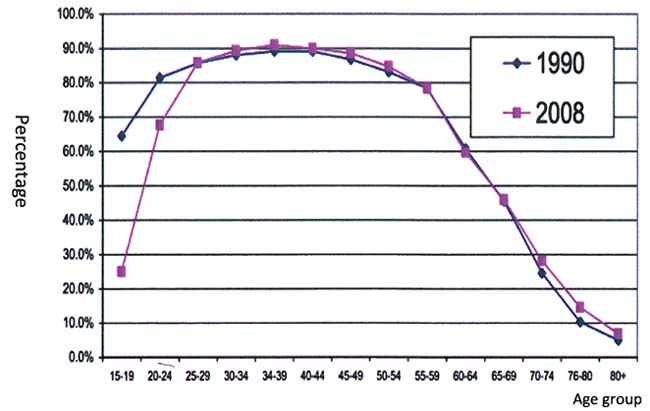
Fig. 2. Percentage of population in labor force in 1990 and 2008 classified by age groups
Source: Labor Force Survey 1990, 2000 and 2008
Educational level of total labor force
Thailand proved to be a more educated society during the period of 1990 to 2008 with labor share of upper secondary and higher education, from 17% in 1990 to 25% in 2008 amid the labor with elementary education or lower decrease from 68% to 57% as shown in Fig. 3.
For workers with lower education, the share of workers with less than elementary level was largest; it comprised 43% in 1990 and reduced to 31% in 2008 at the negative growth rate of 0.6% over 1990-2008 as shown in Fig. 4. Workers with no education, the lowest group, were down from 3.5% to 2.9. Workers with elementary education, the second largest group, were up from 21.4% to 23% at the rate of 1.8%. Workers having lower secondary education increased at 2.3% with share rising from 13.0 to 15%.
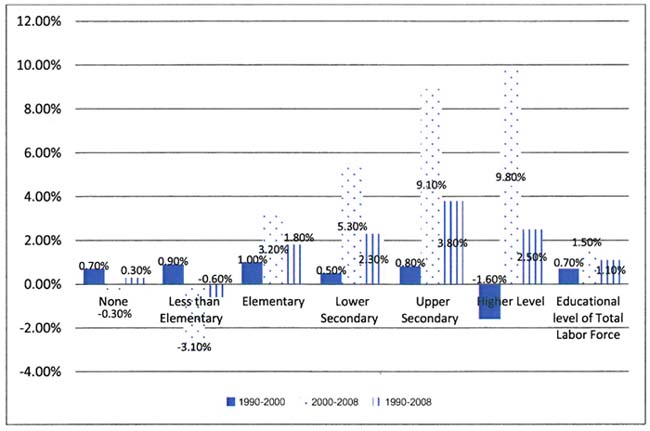
Fig. 3. Educational levels of total labor force from 1990 to 2008
Series 1: 1990-2000, Series 2: 2000-2008, Series 3: 1990-2008
Source: Labor Force Survey 1990, 2000 and 2008
Educational level and labor force structure changes
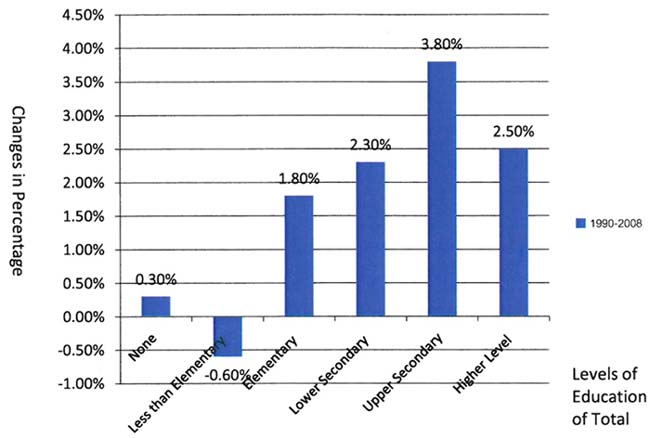
Fig. 4. Changes in levels of educational attainment of total labor force from 1990 to 2008
Source: Labor Force Survey 1990, 2000 and 2008
As the educational attainment of total labor forces became higher from 1990 to 2008, the agricultural labor percentage declined by 0.90% and non-agricultural labor increased by 7.5% in the same period. This could probably mean higher educational attainment induced the labor to shift from agriculture to non-agricultural sectors like manufacturing and service sector. Meanwhile, the aging population increased slightly.
Minimum wage rate
According to ILO, the “minimum wage rate” is the minimum rate of wages determined by the wage committee under the registered migrants under the Labor Protection Act (1998). It is an indicator of the workers’ standard of living. The minimum wage rate is based on the cost of living, which incorporates all basic needs (foodstuff, shelter, transportation fare, basic medical care and other miscellaneous private expenses). After decentralizing the government wage policies, minimum wages are now set in Thailand by regional agencies as shown in Fig. 5.
From 2003 to 2006, Thailand’s economy entered an expansionary phase, demonstrated by the consistent increase in the GDP growth rate, at around 4.5–7%, the highest range after the 1997 financial crisis (Bank of Thailand, 2010). However, minimum wages have not been adjusted to inflation on a systematic basis and therefore real minimum wages have declined. In 2012, according to the Ministry of Labor (2012), workers in only seven provinces receive a minimum wage rate of 300 baht per day. The Wage Committee announced on 2 November 2011 that minimum wages would be set at 300 Baht per day for 7 provinces (Bangkok, Nakorn Pathom, Nonthaburi, Pathum hani, Phuket, Samutprakarn, and Samutsakorn. These provinces are in the central area and close to Bangkok). This entered into force from 1 April 2011. In October 2012, the Wage Committee made a further announcement that wages in the remaining 70 provinces would also be set at 300 Baht, starting from 1 January 2013 (Ministry of Labor of Thailand, 2012). It implies to the same wage rate of 300 baht per day in 2015 according to Bank of Thailand. (ILO, 2015).
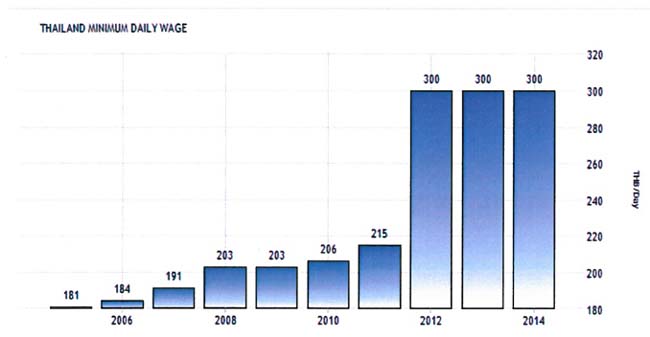
Fig. 5: Minimum daily wage rate
Source: http://www.tradingeconomics.com
Impacts of alien workers on Thai economy
Thailand has been relying on the alien/ migrant workers from its neighboring countries where the minimum wage rates are lower. The daily minimum wage rates are shown in Table 1. Thailand has the highest rate of minimum wages with 8.22 US $, followed by Malaysia (5.97-6.71 US$), Cambodia (4.13US$), and Myanmar (2.77US$). Lao PDR is found to have the lowest level of minimum wage rate among Thailand’s neighboring countries. Since Thailand is standing the position of highest paid countries, the labor from neighboring countries continue to migrate Thailand and this make up the partial labor force for the country. The labor force of alien workers is fulfilling the labor shortage of Thailand’s various industry.
Table 1. Minimum wage rates in Thailand and its neighboring countries
(Unit: US$)
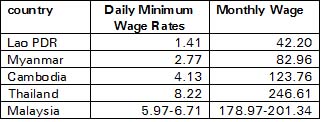
Source: Department of Labor and Employment of Philippines (2015)
The Kasetsart University and Office of Agricultural Economics (KU-OAE) Foresight Center which is called KOFC has done an analysis on the impacts of alien workers on Thailand’s Economy. It was found that these workers increase value addition in Agricultural Production Sector approximately about 252,810 million baht. In this regard, agricultural sector is contributing by 27,233.31 milllion baht or about 10.77% of total production sector as can be seen in Table 2.
Table 2. Number of alien workers employed in each different sector in 2014
(Unit: person)
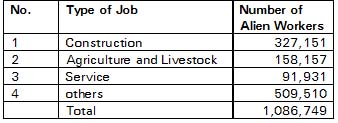
Source: KOFC, Office of Agricultural Economics (2014)
The Contributions to Agricultural Production by alien workers in each type of agricultural product are calculated by KOFC. It was revealed that livestock was the most value added by these workers which is roughly 3,449 million Baht followed sugarcane and rice as approximately of 2,956 million Baht and 2,932 million Baht respectively as shown in Table 3 as follows;
Table 3. The contributions to agricultural production by alien workers in 2014
(Unit: million baht)
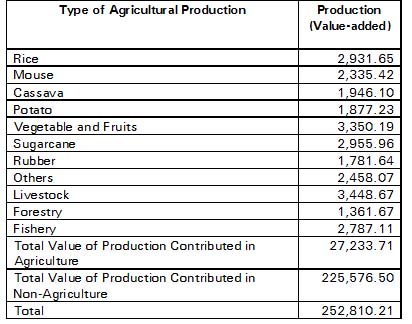
Source: KOFC, Office of Agricultural Economics (2014)
As it can be seen in Table 4, the highest number of Alien/migrant workers is from Cambodia where the minimum wage rate is almost half of that of Thailand. The second and third highest number of migrant laborers come from Myanmar and from Lao PDR where the minimum wage rate is almost one-fourth and one-eighth that of Thailand, respectively.
Table 4. Thailand’s registered number of alien workers registered in 2014
(Unit: person)
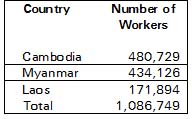
Source: KOFC, Office of Agricultural Economics (2014)
CONCLUSION
There are several recommendations to the government and decision makers to increase employment in agriculture sector which has been facing shortage of labor. In the recent decade, the high number of aging population is working in agriculture sector and many youth went to high schools and universities in the city. They would be reluctant to come back to work for their ancestors’ farming activities and rather engaged in non-agricultural sector because agriculture is believed to be a tiresome career, which rely mostly on weather conditions and has lower amount of income.
The first recommendation is to encourage the educated youth workers and/or from the farming ancestors to engage in agriculture. This will enhance value-added agricultural products and wages in this sector due to increased number of skilled and youth labor.
Agriculture is considered to be climate dependent, tiresome, and risky. There should be social protection support to farmers and farming households to overcome financial constraints and to enable them to manage risks that will affect their income. Provision of social protection in the form of social insurance scheme will have positive impacts on production and farm-level investments in agriculture. Such a social secure agricultural livelihood would likely attract the youth to be involved in farming. The current farmers which would have social insurance will also be able to avail themselves of medical treatment for rehabilitation. This rehabilitation from social insurance will help safeguard, and restore illness for the work of farmers. This means, establishing social insurance scheme either by private sector or by government can promote sustainable food systems, natural resource management and resilient livelihood.
Other recommendation to solve labor shortage in the agriculture sector would be to encourage and improve farm mechanization which will require small number of labor, save time in operation and become more effective.
Alien/migrant workers have been providing the required labor force in Thailand’s economy. Their role is huge. Therefore there should be adequate and reliable data and information for successful implementation of policies regarding the handling of migrant labor force. There is a strong need for the registration process of alien workers to be provided with one-stop service for quick and reliable access of the data and information regarding alien workers.
REFERENCES
Aemkulwat C., (Jan, 2010) Labor Force Structure Change and Thai Labor Market, 1990-2008
Bank of Thailand,2015. Minimum Wage Rate of Thailand, accessed from www.tradingeconomics.com
Department of Labor and Employment of Philippines (2015) Comparative Wages in Selected Asian Countries, National Wages and Productivity Commission, Republic of the Philippines
http://www.nwpc.dole.gov.ph/pages/statistics/stat_comparative.html
ILO, (2015) Thailand – A labour market proile ILO Regional Ofice for Asia and the Paciic Bangkok, ISBN 9789221269038
KOFC, Office of Agricultural Economics (2014) Impacts of Alien Workers on Thailand’s Economy ( in thai)
Nitungkorn, S, 1985, “The Changing Labor Force and Employment Problem in Thailand,” Southeast Asian Studies, Vol. 38, No. 2 (September) pp. 173-92.
Siamwalla, A. (1996), Thai Agricultural: From engine of growth to sunset status. TDRI Quarterly Review, Vol.11, no.4, December, 3-10.
Singelmann, J., "The Sectoral Transformation of the Labor Force in Seven Industrialized Countries, 1920-1970" The American Jouranal of Sociology, Vol. 83, No. 5 (March) pp. 1224-1234.
|
Date submitted: Dec. 10, 2015
Reviewed, edited and uploaded: Dec. 11, 2015
|


Changes in the Agricultural Labor Force of Thailand and the Impact of the Alien Workers on its Economy
Abstract
Agriculture was once an engine in the economic growth of Thailand. However, the employment in agricultural sector has been declining and the dependence of economy on agriculture has declined since a few decades ago. Thailand has transformed to be an industrialized country from an agrarian country. The agriculture sector has been confronting with the issue of labor shortage.
This study finds out the changes in the agricultural labor force status of Thailand over the periods of time in terms of employment status from agriculture to non-agriculture, educational attainment, percentage of the population and minimum wage rate. Thailand could take advantages from increasing number of migrant/alien workers from its neighboring countries who come to the country due to its highest minimum wage rate. It was found that the alien/migrant workers have been contributing to the production and the economy. These workers could supplement the labor shortage in the agricultural activity.
Keywords: Agriculture, labor force, Thailand, alien workers, impacts on the economy
Changes in the agricultural labor force of Thailand
The agricultural sector of Thailand was once an engine of the country’s economic growth. Over the past four decades, agricultural land expansion has increased the outputs of the economy and the agricultural sector gained a major comparative advantage in the international trade. Due to its labor-abundance in the past, agricultural sector could even provide supplies to the industrial sector with cheap labors and other production factors. Agriculture has been playing a crucial role even though land surplus started to vanish in the 1980s. (Siamwalla, 1996)
The share of export to GDP has increased from 26% in 1990 to 64% in 2008. Thailand has moved from classic primary export dependence where there was a restricted expansion of manufacturing employment of only 14% of the labor force in 1990 to export-lead industrialization where there was a greater use of labor in the manufacturing industry accounting for 19.5% in 2008. Nevertheless, even though Thailand exports about more than half of its GDP, it is very interesting to note that Thailand has a larger service sector than the manufacturing sector. The changes in industrial structure in Thailand were largely similar to those in Japan. From 1920-70, in Japan, the decline of agriculture has led directly to the expansion of services. The employment in the manufacturing industry peaked around one-third of the total labor force (Singelmann, 1978).
From 1947-2008, Thailand has also experienced a drastic decline in agricultural employment from 84.8% in 1947 to 42.4% in 2008, a rapid rise in service employment from 12% to 33%, and an increase in manufacturing employment from 2.4% to 20% (Nitungkorn, 1985). In 2008, the service employment share is 8 percentage points higher than the manufacturing employment share.
From an agrarian country, Thailand has turned out to be a more industrialized country. Labor market has been transformed in various dimensions such as population, education, labor force structure, wages and working hours. Thailand becomes an even more educated society. Workers with secondary level of education or higher increased from 17% in 1990 to 25% in 2008.
As shown in the Fig. 1, the percentage of agricultural labor shows a significant decline from 72.99% in 1975 to 34.26% in 2015 September according to the Labor Force Survey. Meanwhile, the labor force employed in the non-agricultural sector rose from 27.01% in 1975 to 65.74% in 2015.
Fig. 1. Percentage changes in the labor force employment status from agriculture to non-agricultural sector in the period from 1975 to 2015
Source: Labor Force Survey in Thailand, National Statistical Office, Ministry of Information and Technology
Percentage of population in labor force from 1990 to 2008
From 1990-2008, labor force population whose ages range from 15-24 declined dramatically while those aged 65 and above increased slightly. More than 80% of the population aged 25-55 participated in the labor market. The population whose ages range from 34-39 was the age group with highest labor force participation; in 1990, the share was 89.0% in 1990 and increased slightly to 90.9% in 2008. The population whose ages range from 15-19 declined in employment from 64.5% in 1990 to 25.0% in 2008 while the population whose ages range from 20-24 decreased in participation from 81.4% to 67.6% because more population aged 15-24 were in school. Labor force participation for population 65-69 was 45.9% in both years, but those for 70 and above was up. Population whose ages range from 70-74 increased from 24.5 % to 28.2% , aged 76-80 increased from 24.5 to 28.2 percent, and aged 80 and over increased from 5.0 to 6.8 percent as shown in Fig. 2. (Aemkulwat, 2010).
Fig. 2. Percentage of population in labor force in 1990 and 2008 classified by age groups
Source: Labor Force Survey 1990, 2000 and 2008
Educational level of total labor force
Thailand proved to be a more educated society during the period of 1990 to 2008 with labor share of upper secondary and higher education, from 17% in 1990 to 25% in 2008 amid the labor with elementary education or lower decrease from 68% to 57% as shown in Fig. 3.
For workers with lower education, the share of workers with less than elementary level was largest; it comprised 43% in 1990 and reduced to 31% in 2008 at the negative growth rate of 0.6% over 1990-2008 as shown in Fig. 4. Workers with no education, the lowest group, were down from 3.5% to 2.9. Workers with elementary education, the second largest group, were up from 21.4% to 23% at the rate of 1.8%. Workers having lower secondary education increased at 2.3% with share rising from 13.0 to 15%.
Fig. 3. Educational levels of total labor force from 1990 to 2008
Series 1: 1990-2000, Series 2: 2000-2008, Series 3: 1990-2008
Source: Labor Force Survey 1990, 2000 and 2008
Educational level and labor force structure changes
Fig. 4. Changes in levels of educational attainment of total labor force from 1990 to 2008
Source: Labor Force Survey 1990, 2000 and 2008
As the educational attainment of total labor forces became higher from 1990 to 2008, the agricultural labor percentage declined by 0.90% and non-agricultural labor increased by 7.5% in the same period. This could probably mean higher educational attainment induced the labor to shift from agriculture to non-agricultural sectors like manufacturing and service sector. Meanwhile, the aging population increased slightly.
Minimum wage rate
According to ILO, the “minimum wage rate” is the minimum rate of wages determined by the wage committee under the registered migrants under the Labor Protection Act (1998). It is an indicator of the workers’ standard of living. The minimum wage rate is based on the cost of living, which incorporates all basic needs (foodstuff, shelter, transportation fare, basic medical care and other miscellaneous private expenses). After decentralizing the government wage policies, minimum wages are now set in Thailand by regional agencies as shown in Fig. 5.
From 2003 to 2006, Thailand’s economy entered an expansionary phase, demonstrated by the consistent increase in the GDP growth rate, at around 4.5–7%, the highest range after the 1997 financial crisis (Bank of Thailand, 2010). However, minimum wages have not been adjusted to inflation on a systematic basis and therefore real minimum wages have declined. In 2012, according to the Ministry of Labor (2012), workers in only seven provinces receive a minimum wage rate of 300 baht per day. The Wage Committee announced on 2 November 2011 that minimum wages would be set at 300 Baht per day for 7 provinces (Bangkok, Nakorn Pathom, Nonthaburi, Pathum hani, Phuket, Samutprakarn, and Samutsakorn. These provinces are in the central area and close to Bangkok). This entered into force from 1 April 2011. In October 2012, the Wage Committee made a further announcement that wages in the remaining 70 provinces would also be set at 300 Baht, starting from 1 January 2013 (Ministry of Labor of Thailand, 2012). It implies to the same wage rate of 300 baht per day in 2015 according to Bank of Thailand. (ILO, 2015).
Fig. 5: Minimum daily wage rate
Source: http://www.tradingeconomics.com
Impacts of alien workers on Thai economy
Thailand has been relying on the alien/ migrant workers from its neighboring countries where the minimum wage rates are lower. The daily minimum wage rates are shown in Table 1. Thailand has the highest rate of minimum wages with 8.22 US $, followed by Malaysia (5.97-6.71 US$), Cambodia (4.13US$), and Myanmar (2.77US$). Lao PDR is found to have the lowest level of minimum wage rate among Thailand’s neighboring countries. Since Thailand is standing the position of highest paid countries, the labor from neighboring countries continue to migrate Thailand and this make up the partial labor force for the country. The labor force of alien workers is fulfilling the labor shortage of Thailand’s various industry.
Table 1. Minimum wage rates in Thailand and its neighboring countries
(Unit: US$)
Source: Department of Labor and Employment of Philippines (2015)
The Kasetsart University and Office of Agricultural Economics (KU-OAE) Foresight Center which is called KOFC has done an analysis on the impacts of alien workers on Thailand’s Economy. It was found that these workers increase value addition in Agricultural Production Sector approximately about 252,810 million baht. In this regard, agricultural sector is contributing by 27,233.31 milllion baht or about 10.77% of total production sector as can be seen in Table 2.
Table 2. Number of alien workers employed in each different sector in 2014
(Unit: person)
Source: KOFC, Office of Agricultural Economics (2014)
The Contributions to Agricultural Production by alien workers in each type of agricultural product are calculated by KOFC. It was revealed that livestock was the most value added by these workers which is roughly 3,449 million Baht followed sugarcane and rice as approximately of 2,956 million Baht and 2,932 million Baht respectively as shown in Table 3 as follows;
Table 3. The contributions to agricultural production by alien workers in 2014
(Unit: million baht)
Source: KOFC, Office of Agricultural Economics (2014)
As it can be seen in Table 4, the highest number of Alien/migrant workers is from Cambodia where the minimum wage rate is almost half of that of Thailand. The second and third highest number of migrant laborers come from Myanmar and from Lao PDR where the minimum wage rate is almost one-fourth and one-eighth that of Thailand, respectively.
Table 4. Thailand’s registered number of alien workers registered in 2014
(Unit: person)
Source: KOFC, Office of Agricultural Economics (2014)
CONCLUSION
There are several recommendations to the government and decision makers to increase employment in agriculture sector which has been facing shortage of labor. In the recent decade, the high number of aging population is working in agriculture sector and many youth went to high schools and universities in the city. They would be reluctant to come back to work for their ancestors’ farming activities and rather engaged in non-agricultural sector because agriculture is believed to be a tiresome career, which rely mostly on weather conditions and has lower amount of income.
The first recommendation is to encourage the educated youth workers and/or from the farming ancestors to engage in agriculture. This will enhance value-added agricultural products and wages in this sector due to increased number of skilled and youth labor.
Agriculture is considered to be climate dependent, tiresome, and risky. There should be social protection support to farmers and farming households to overcome financial constraints and to enable them to manage risks that will affect their income. Provision of social protection in the form of social insurance scheme will have positive impacts on production and farm-level investments in agriculture. Such a social secure agricultural livelihood would likely attract the youth to be involved in farming. The current farmers which would have social insurance will also be able to avail themselves of medical treatment for rehabilitation. This rehabilitation from social insurance will help safeguard, and restore illness for the work of farmers. This means, establishing social insurance scheme either by private sector or by government can promote sustainable food systems, natural resource management and resilient livelihood.
Other recommendation to solve labor shortage in the agriculture sector would be to encourage and improve farm mechanization which will require small number of labor, save time in operation and become more effective.
Alien/migrant workers have been providing the required labor force in Thailand’s economy. Their role is huge. Therefore there should be adequate and reliable data and information for successful implementation of policies regarding the handling of migrant labor force. There is a strong need for the registration process of alien workers to be provided with one-stop service for quick and reliable access of the data and information regarding alien workers.
REFERENCES
Aemkulwat C., (Jan, 2010) Labor Force Structure Change and Thai Labor Market, 1990-2008
Bank of Thailand,2015. Minimum Wage Rate of Thailand, accessed from www.tradingeconomics.com
Department of Labor and Employment of Philippines (2015) Comparative Wages in Selected Asian Countries, National Wages and Productivity Commission, Republic of the Philippines
http://www.nwpc.dole.gov.ph/pages/statistics/stat_comparative.html
ILO, (2015) Thailand – A labour market proile ILO Regional Ofice for Asia and the Paciic Bangkok, ISBN 9789221269038
KOFC, Office of Agricultural Economics (2014) Impacts of Alien Workers on Thailand’s Economy ( in thai)
Nitungkorn, S, 1985, “The Changing Labor Force and Employment Problem in Thailand,” Southeast Asian Studies, Vol. 38, No. 2 (September) pp. 173-92.
Siamwalla, A. (1996), Thai Agricultural: From engine of growth to sunset status. TDRI Quarterly Review, Vol.11, no.4, December, 3-10.
Singelmann, J., "The Sectoral Transformation of the Labor Force in Seven Industrialized Countries, 1920-1970" The American Jouranal of Sociology, Vol. 83, No. 5 (March) pp. 1224-1234.
Date submitted: Dec. 10, 2015
Reviewed, edited and uploaded: Dec. 11, 2015